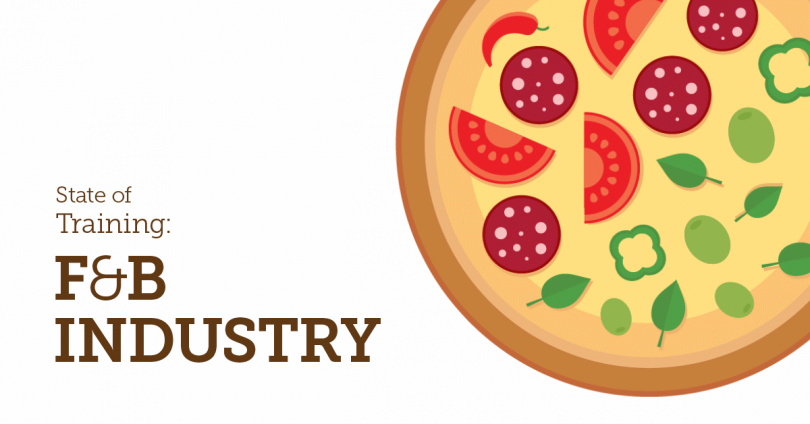- What type of training do employees receive?
- Is training satisfactory?
- How is training usually delivered?
- The differences between online and offline training
- How does regular training create better employees?
- How much training is too much?
- Who’s the best trainer (according to employees)?
- Creating the best food industry employee training program
- Data: Who provided feedback
The food and beverage industry is one of the most profitable, best-performing markets in this tiny planet called Earth. According to Plunkett Research, as of 2017, the global market was estimated to be over $8.1 trillion, representing more than 10% of the world’s GDP.
Think of it this way. Apple Inc. is worth 1 trillion. This alone means that the F&B industry could buy eight companies as big as Apple, and have enough money for a luxurious mansion in the Hamptons, and a collection of Lamborghinis.
So, how could there be anything wrong?
Well, there are currently 15.1 million people who work in F&B businesses across the US. That’s a number marginally smaller than the entire population of the Netherlands.
And unfit training for these 15.1 million is what’s wrong.
We asked employees in various roles at small and medium-sized businesses to share their experience with food industry training. We hate spoilers, but it’s about time we cut to the chase.
To reveal a sneak peek, one of the survey’s main findings suggests that food and beverage training is, more or less, stuck in the Dark Ages.
More specifically, 52% of our respondents say they only received training when they started working at their current position (a.k.a. onboarding training). This means that only 48% of employees have some experience with continuous learning at work.
Hooked? Just wait to see what’s coming. Keep reading for a brief analysis of the state of employee F&B training in food and beverage SMBs.
What type of training do employees receive?
Compliance training dominates the industry. 38.5% of employees in our survey indicated they had received quality assurance, compliance, food safety training. Customer service coaching serves as the deputy governor in the land of food and beverage employee training (25.5%), followed by management training (21%).
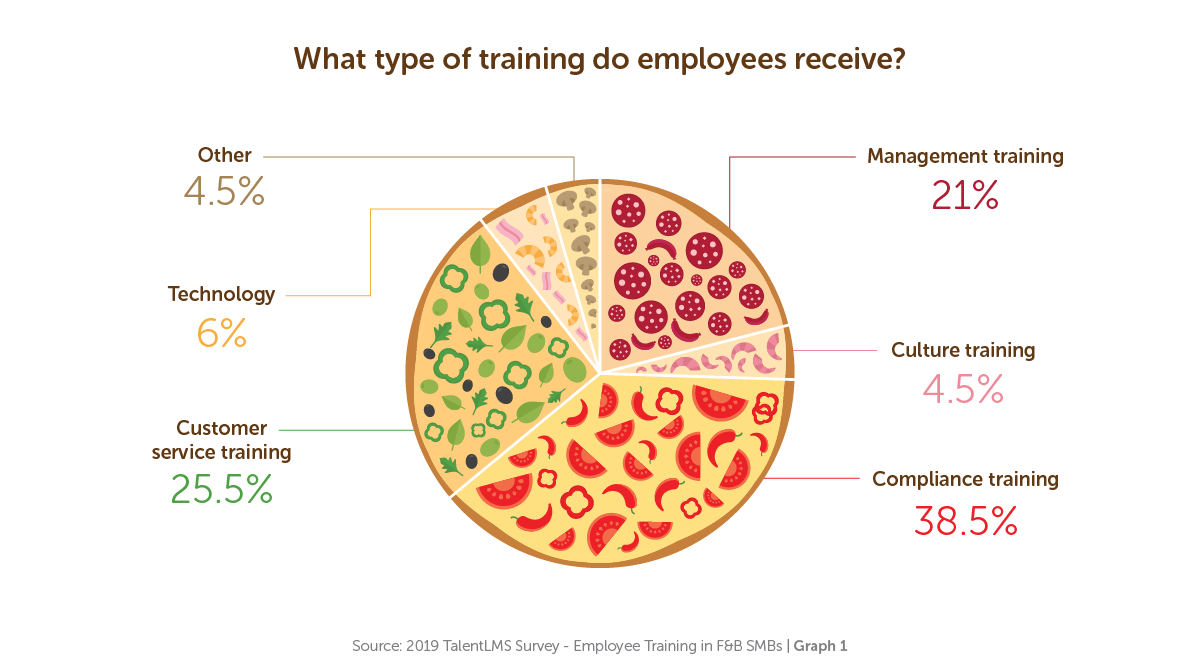
By default, the industry is characterized by face-to-face interaction between workers and customers, which means that employees act as representatives of the business they work in. In fact, 89% of our respondents were in customer-facing roles. Along these lines, someone could easily assume that company culture training would be a priority for F&B organizations.
Instead, only 4.5% of employees receive any sort of training on company mission – which is stranger than fiction. A company representative not knowing their company’s values is like a salesperson not knowing the products they sell. And yet, basic training for restaurant staff includes no culture-related instruction.
Sadly, it isn’t just the seed of the company culture idea which hasn’t grown yet. The problem is that proper customer service is neglected.
We asked employees in customer-facing roles about the type of training they receive. And the ugly truth is that 70% of them say they’ve never received any training on customer service.
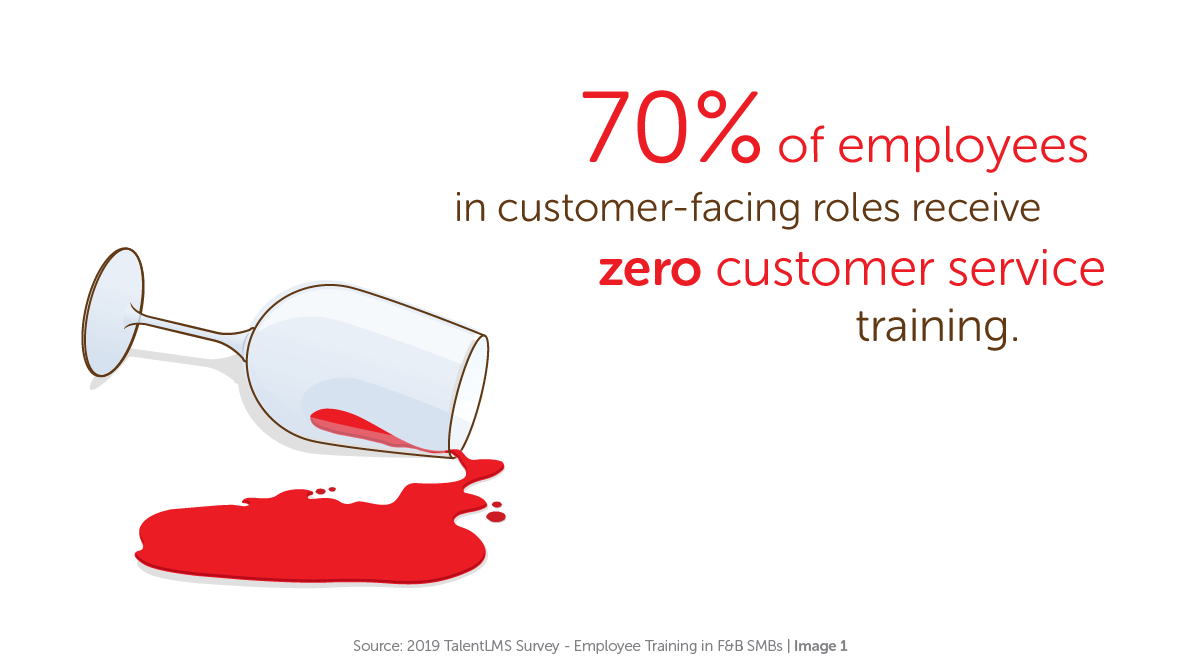
We talked to Tyler Richins, Training Director at Chick-fil-A restaurants, top limited-service restaurant in customer satisfaction, who gave his take on restaurant customer service training and how much of a priority it is for businesses today.
From what we’ve seen so far, a training schedule for restaurant staff doesn’t include customer service training. Is it neglected?
“I would say that this is absolutely true. Given my previous experience in sales and recruiting, I never had any formal training in customer service. My training was mostly about closing the sale and how my software works.
Most striking, though, is how much of an impact customer service has on a business and their growth, yet it is not at the forefront of most training plans out there. In today’s world, we are saturated with products and services; however, the price will come in second to customer service. The Company/Brand with the best customer service will win out every time, even if it costs a little extra. Chick-Fil-A is a great example!”
But what do employees think? We asked respondents what areas they’d like to receive more training on. “Customer service training” was the second most popular answer.
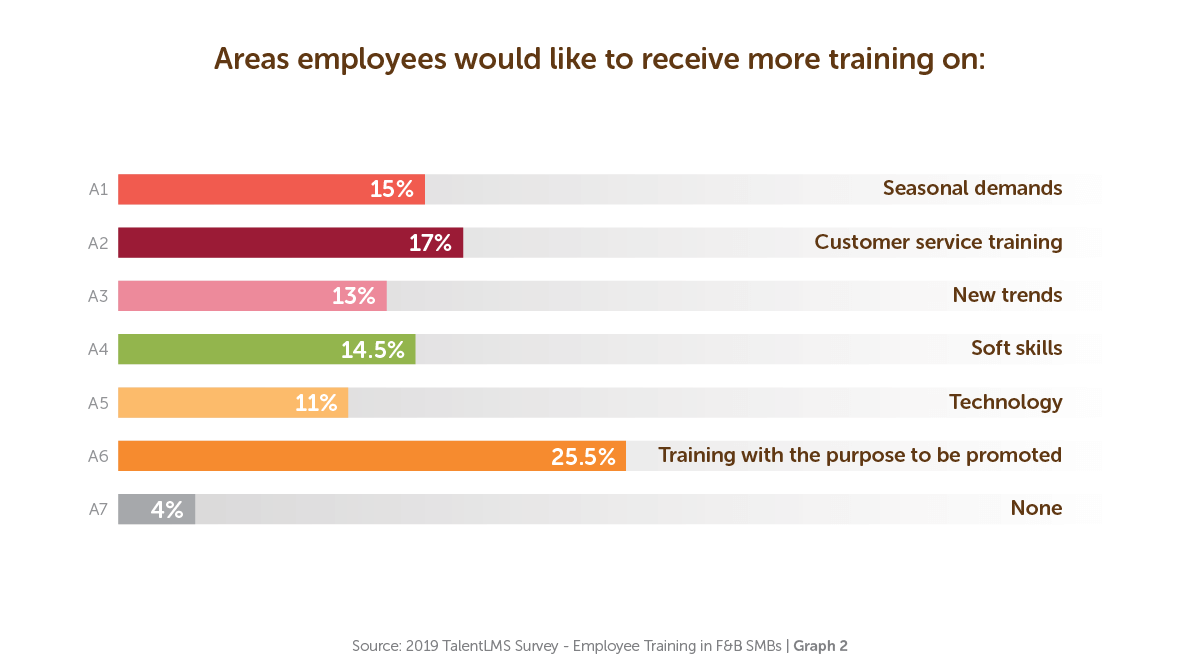
Is training satisfactory?
In terms of satisfaction with food industry training, the scores are not that disappointing. The majority of our respondents (59.5%) confirmed their satisfaction with their overall training. Then again, and on the chance you see the glass half empty, you’re not entirely wrong: the remaining 40.5% is still unsatisfied.
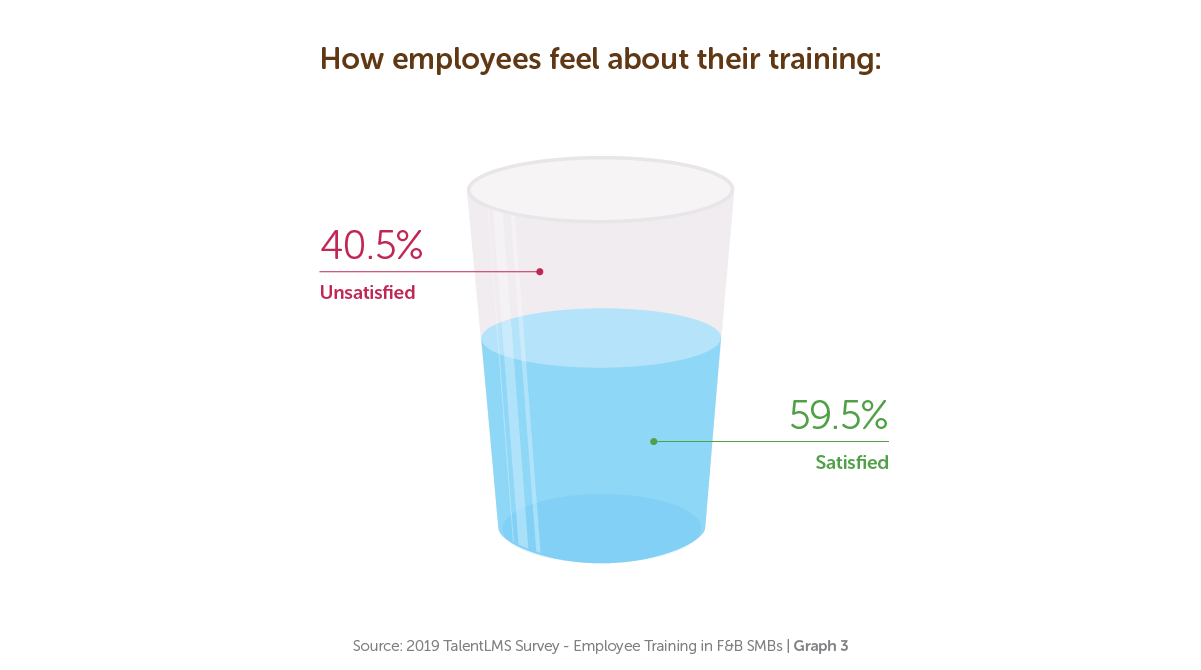
When asked to describe their training, 75% depicted it as compelling, constructive, and team-building. In detail:
- 43.5% of respondents said training boosts their motivation
- 47% of respondents said their training builds their confidence
- 46% of respondents elevated their problem-solving skills through training
- 61.5% said that training enhanced their overall professional performance
- 4% of respondents say they don’t want any more training
If those numbers don’t impress the importance of training for building a motivated, smart and skilled workforce, this will. We asked employees whether lack of training of any kind (food safety training, staff training, restaurant management training, etc.) would influence their decision to leave a company.
Sixty-two percent said yes.
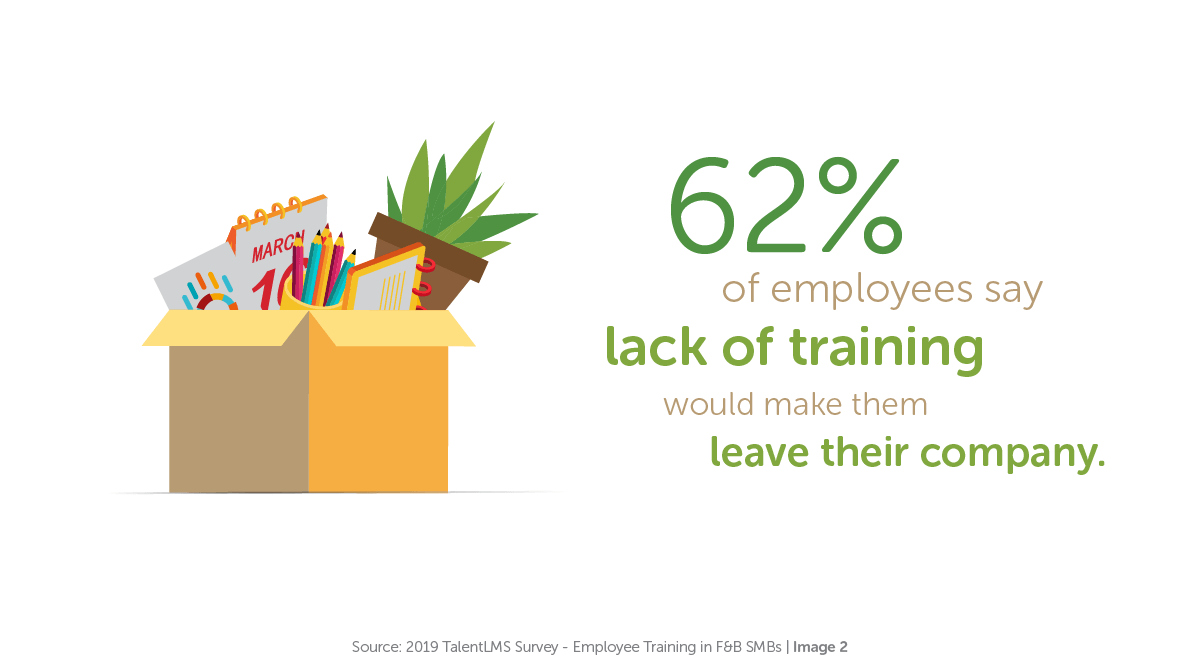
We, likewise, asked what would make them stay longer in their current company. Here are the top three answers ranked by popularity:
- A salary bump
- More chances to move up within my company
- More and better training for my role
Let’s be honest: when someone mentions they work in the F&B industry, some eyebrows automatically go up. For reasons unknown, people still trust that employees in the industry see their jobs as temporary.
According to our survey, 44.5% see their job as a stepping stone in their career in this industry. This means that a lot of F&B employees look to evolve as professionals and thrive in the industry. With that being said, companies need to invest in restaurant staff training because employees want it.
How is training usually delivered?
Picture training as a chessboard. At 62%, offline training is the King, online training (38%) is the Queen, and, with just 6%, mobile training is the pawn you’d forfeit first.
The most popular offline delivery method is face-to-face training. This makes sense because we’re talking about workers who’re not office-bound and require deskless training. That’s why restaurant training often involves physical interaction. In online training, we found that a variety of methods are used with the biggest slice of the pie belonging to LMSs.
Speaking of pies:
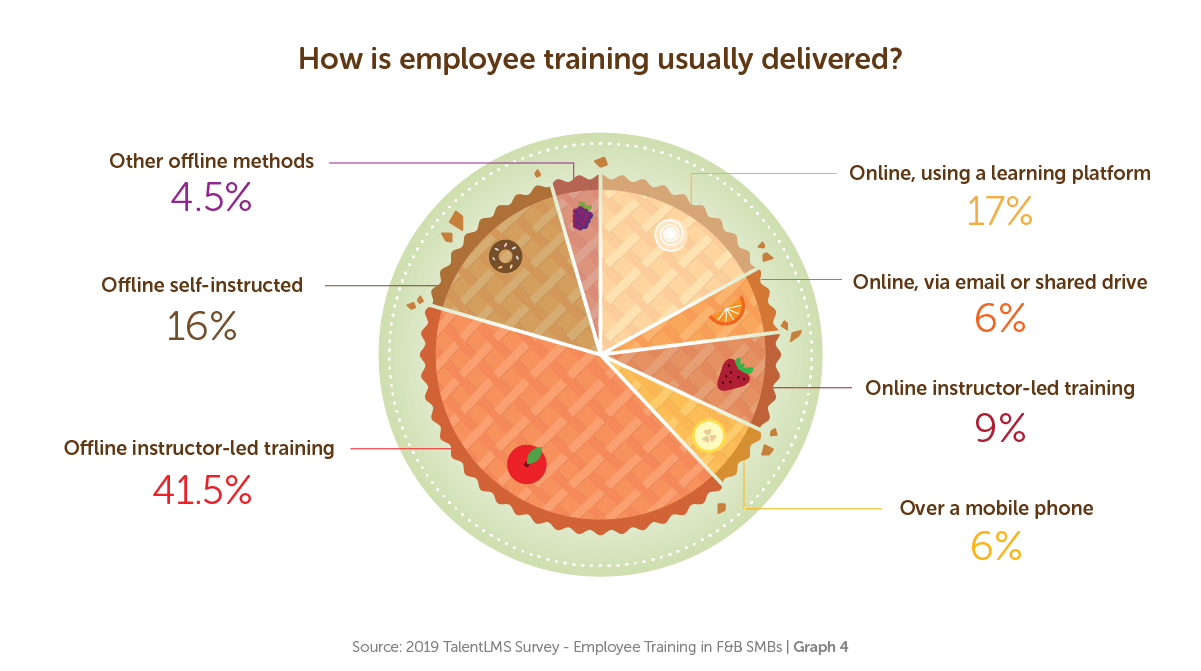
By examining employees who receive online food & beverage training, we came up with an interesting finding. A pattern. Usually, companies who invest in online training have organized HR or training departments.
And we see this because 43% of employees who receive online training indicate they’ve been trained by HR/training managers or external trainers. In the meantime, only 25% of offline learners have dealt with professionals in similar positions.
Could this mean that small and medium businesses feel that online training is not suited for their size? Is it a coincidence that almost half of respondents (44%) who work in the F&B sector in hospitality, receive hospitality training?
Richins addressed the benefits of online training in the food industry:
“As the Training Director of a restaurant, I don’t need to remember all 360+ training modules; everything’s on my phone now. I also have the flexibility and customization to build my own training plans for each section of the restaurant. Having our standards just a click away, we are able to offer strong in-person training. If I don’t know the answer, it’s right on my mobile phone.”
The differences between online and offline training
By now, we already know how important training is for employees. But does the way you deliver that training make a difference?
Our team compared online with offline training to see how each one performed across a number of factors.
Forty-two percent of offline learners see their current position as a stepping stone in this industry. Not bad, right? They want to stay where they are but grow. This is good news for those high turnover rates well-known across the industry. Now, what if we told you that the number goes up to 52% for employees who have been trained online?
Interestingly, delivering training using online methods also seems to affect the pace of training. Sixty-percent of online learners were more likely to receive training at regular intervals compared to only 35% of offline learners.
As the Latin proverb goes: “Repetition is the mother of learning,” and this is precisely why regular training should be among an employer’s first priorities. And as it turns out, we found that employers who’ve invested in online training have invested in continuous learning as well.
Amazingly, only 35% of offline learners receive training regularly, while 60% of online learners get any type of training (i.e., F&B, food safety, restaurant training, etc.) at regular intervals. Thus, it’d be wise to say that when we’re talking about regular food industry training, we’re basically talking about online training.
How does regular training create better employees?
One of the critical questions of this survey was the point at which we asked our respondents to rate how much training has helped them in each one of the following areas:
- Motivation
- Confidence
- Teamwork
- On-the-job performance
- Loyalty to the company
As you may have guessed, satisfaction scores from those who receive regular training were greater than the daily calories of a sumo wrestler. On the contrary, satisfaction scores from employees who’d received onboarding training only seemed to be on a strict diet.
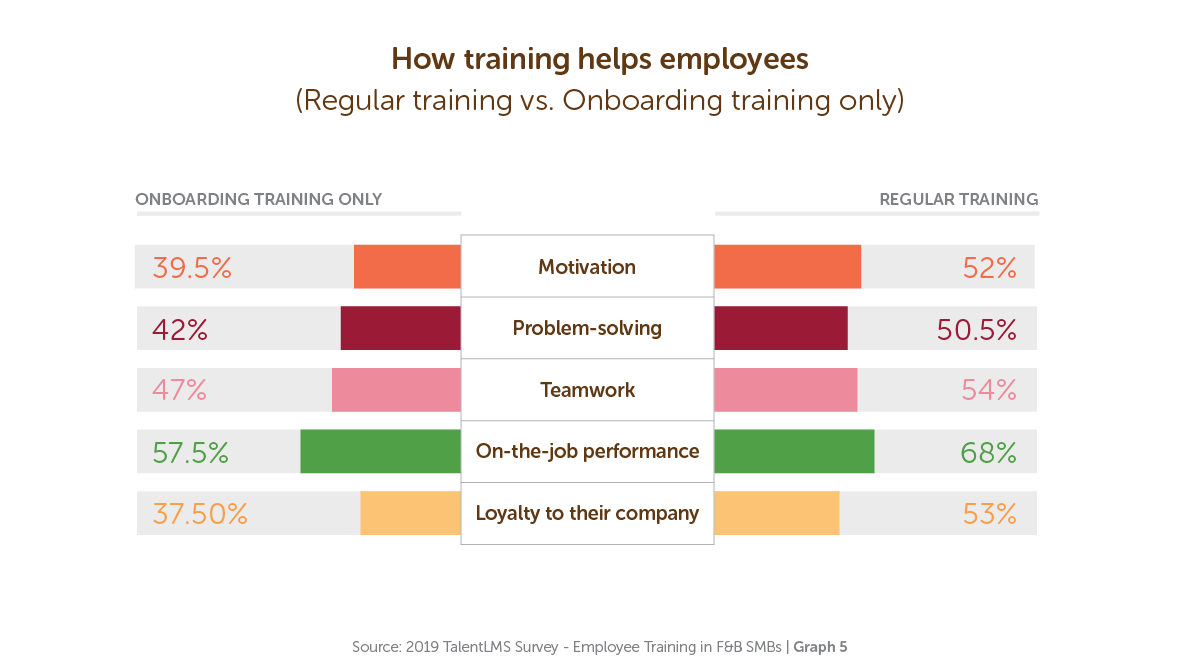
Did you notice the drop-dead striking finding? Fifty-three percent of employees who receive regular training say it’s made them more loyal to their company. Take a careful look, and you’ll see that only 37.5% of employees who’ve received onboarding training have increased their loyalty levels.
We wanted to crosscheck.
According to our respondent demographics, the vast majority of regular trainees (70%) has been working at their company for more than a year.
And as for those who received onboarding training only? Fifty-four percent leave their company before their first work anniversary.
How much training is too much?
We know regular training is associated with better performance. But we need to define “regular.”
After we asked our respondents how frequently they receive any form of F&B training, we asked them how fulfilled they felt with their overall training experience. Those who were trained week after week and month to month didn’t demonstrate any enormous contrast (65.5% and 67% respectively). For the record, those who were trained yearly scored a satisfaction rate of 33%.
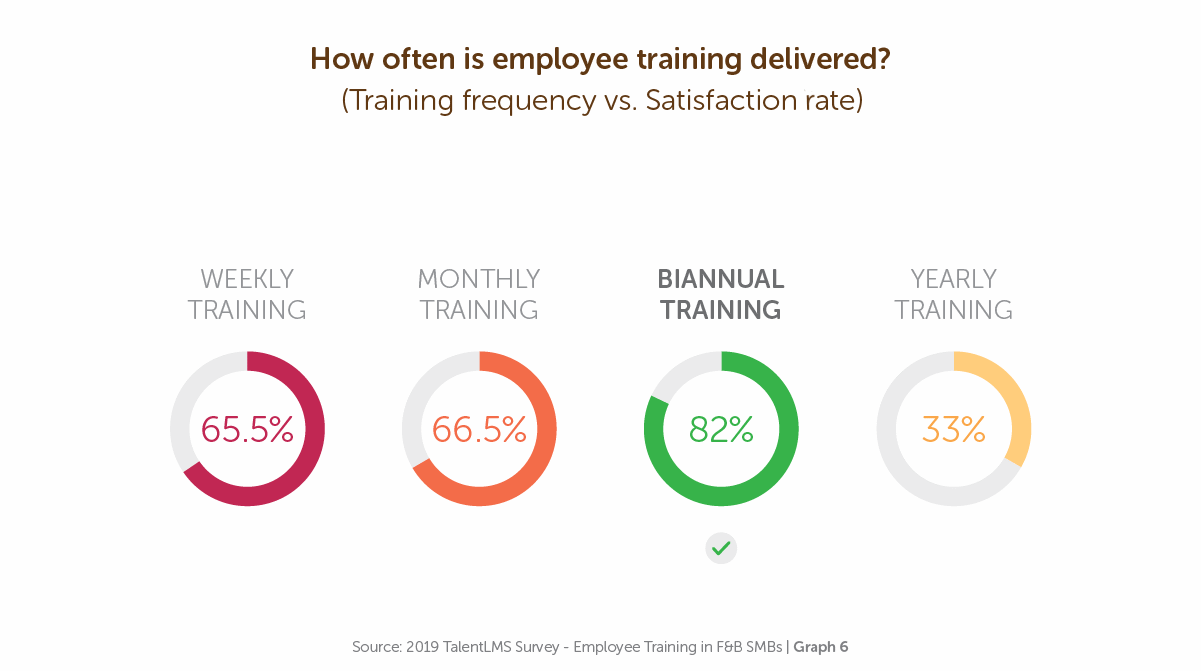
Who’s the best trainer (according to employees)?
By now, we know what type of training is (and should be) given. What delivery methods are used. How regular training makes better employees.
Time to take a look at who needs to take charge of training.
We combined employee training satisfaction scores with answers to the question: “Who’s your main instructor?” This way, we measured how much impact trainers had on employee training satisfaction.
Most employees were trained by their managers which, as an option, ranks first as far as satisfaction is concerned (64% satisfaction score). FYI, this finding is also backed by our “Satisfaction with Onboarding” survey which showed that meeting a supervisor on day one positively affected all levels of satisfaction.
In many cases, however, employees were trained by a co-worker — probably training in restaurant service. The satisfaction rate didn’t exceed 42%.
Creating the best food industry employee training program
So, all this talk for what? We’re not usually into bragging, but the survey was a pure success.
The findings aren’t just interesting for professionals who work in the food and beverage industry and need training. They’re also able to provide some actionable advice on how employers or training developers can create the best employee training program for the Food and Beverage industry.
Here you go:
1. Give employees training
From what we’ve seen up until this point, workers love training, and it helps them become better professionals in several areas, including job performance.
2. Focus on what they want
Our respondents were crystal clear. There are explicit types of training they want the most.
First off, they want training that will help them grow and be promoted. Contrary to popular belief, professionals in the industry want to advance and evolve.
Second, offering training on restaurant service to employees in customer-facing positions should be an established fact. Not just because employees want it, but certainly because with better customer service, customers’ appreciation is destined to follow.
3. Invest in online training
The numbers have spoken once again. Online training increases employee engagement whether we’re talking about food safety and hygiene training or food and beverage training in hospitality.
Likewise, it’s here to demonstrate that online learning isn’t just a flashier and more refined delivery method. In fact, companies who’ve invested in online learning, have invested in continuous training as well.
4. Invest in regular training
Regular learning makes better employees. That’s guaranteed. But wait. There’s more!
With regular training, you’re not just allowing your employees to grow as professionals. You’re allowing them to grow as individuals by giving them a broad set of abilities: better on-the-job performance, problem-solving and teamwork skills, motivation, and advanced loyalty to their company are just a few to note.
Just a heads-up, though. Don’t try too hard. According to our survey, training your employees every six months will get the job done and leave your employees with a taste of satisfaction as well. Still not convinced? Let your employees speak. Create a survey and ask them how much training they’d like to receive, so you get to know firsthand.
5. Keep your training human-centered
As mentioned before, online training comes with a broad set of advantages. Our findings, however, indicate that learners need human connection as well. Ask from employees in managerial positions to take charge of training. It doesn’t matter whether we’re talking about basic training for restaurant staff or generic training for the food industry. The point is trainees want them as mentors.
For an industry brimming with an assortment of people, experimentation with delivery methods ought to be considered. Combine the right amount of online training with the right amount of offline learning to create the perfect recipe.
Exactly. A blended learning program for a diverse, blended industry.
Data: Who provided feedback
For this report, we surveyed 200 people who work exclusively in the Food and Beverage industry and have received some kind of training at least once as part of their jobs.
Our respondents are all located in the US and come from various roles in many different specialties in the food and beverage industry in managerial, behind-the-scenes (19.5%), and customer-facing positions (80.5%). They’re all employed for wages with different incomes.
